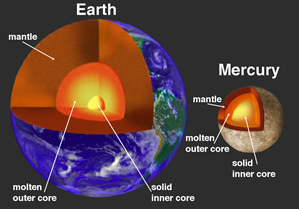Sulphur in the inner core of the planet Mercury: impact on elastic properties
Sulphur in the inner core of the planet Mercury: impact on elastic properties
Promotor(en): S. Cottenier, T. Van Hoolst /15_MAT02 / Solid-state physicsThe planet Mercury has long been the least known of the terrestrial planets. Whereas Mars and Venus have been visited by several tens of spacecraft since the start of the space era, only one spacecraft (Mariner10) has flown by Mercury (1974-1975) and the first spacecraft ever to enter orbit around Mercury was MESSENGER (MErcury Surface, Space ENvironment, GEochemistry and Ranging) on 18 March 2011. With the wealth of data gathered by the NASA MESSENGER spacecraft and the ESA/JAXA BepiColombo mission readying for launch in 2016, the focus of the planetary science community on Mercury is stronger than ever. One of the primary goals of these missions to Mercury is to gain a deeper understanding of the interior structure and evolution of this smallest terrestrial planet with an exceptionally large core.

A primary goal of the space missions MESSENGER and BepiColombo and of many theoretical, observational, and experimental studies is to understand the formation, evolution and interior structure of Mercury. A major problem is that direct experimental data about the high-pressure behavior of putative bulk Mercury chemical compositions are very scarce. As a result, all studies to date have had to either simplify interior property models, or use thermodynamic models to predict interior mineralogy based on experiments performed at conditions of pressure, temperature, composition, and oxygen fugacity far outside those invoked for Mercury.
One issue that will contribute to a better characterization of the physical properties and structure of the iron-rich core of Mercury, is understanding the influence of sulphur on the elastic properties of high-pressure phases of iron. This is essentially a materials engineering question, and the expertise you will build during this work is therefore immediately applicable to materials physics studies at ambient pressure as well.
Goal You will apply ab initio methods (density-functional theory) to predict the elastic properties of iron (1) as a function of pressure, (2) for different relevant crystal structures, (3) with various concentrations of sulphur and (4) as a function of the lattice location and distribution of sulphur within the iron matrix. Extending these predictions as a function of temperature is an option as well. Your calculated data will allow to unravel the mechanism by which sulphur affects the elastic properties. Your predicted values will be used to interpret experimental work on the same material.
This work will be performed in dialogue with scientists at the Royal Observatory of Belgium, who are involved in space missions to Mercury.
- Study programmeMaster of Science in Engineering Physics [EMPHYS], Master of Science in Physics and Astronomy [CMFYST]ClustersFor Engineering Physics students, this thesis is closely related to the cluster(s) modelling, materials, nano

